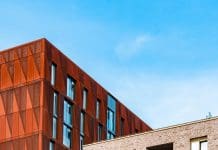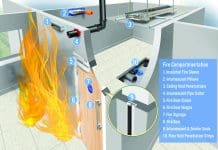New guidance from NHBC provides builders, designers and regulators with possible solutions for stairs in residential buildings where building regulations calls for them to be constructed from materials of limited combustibility.
Approved Document B (Volume 2 clause 5.19) recommends that in residential buildings over three storeys with a single escape stair, the stair should be constructed out of materials of limited combustibility.
This is considered necessary for the following reasons:
- The stair is the only means of escape for residents on the upper floors;
- The risk to the stair as a consequence of an arson attack within the stairwell is significantly greater if the stair is made from a combustible material.
However, research into the use of timber stairs was undertaken by BRE as part of the Timber Frame 2000 project, culminating with the 2009 publication of Report BD2569 – Fire Performance of Timber Stairs. One of the conclusions of this research was that fire retardant timber treatment could be used, both impregnated and surface applied, to lessen the charring caused in a fire situation and therefore provided evidence that timber can perform satisfactorily in a fire situation under certain circumstances.
The guidance from NHBC can therefore be followed if the design or particular method of construction lends itself more easily to the use of timber stairs rather than a stair constructed out of concrete or steel perhaps. The guidance is applicable to residential buildings of all types of building construction not exceeding six storeys or with a top floor less than 18m above ground level.
Both Approved Document B Volume 2 and BS9991 have several references to the need to ensure a robust, fire resisting enclosure to a stairwell, to restrict the use and fire load of the stairwell and rooms accessed directly off it, and to provide vents to remove heat and smoke. The need for the stair itself to remain largely non-combustible is considered to be an integral part of this.
There are three ways to satisfy the requirements of Part B in respect of staircases in single stair residential buildings exceeding three storeys:
1. The stair should comply with the limited combustibility recommendations of AD B Table A7. Softwoods and MDF are unable to achieve this standard and cannot therefore be accepted as materials of limited combustibility;
2. Using a timber stair from a manufacturer who has obtained a suitable, independent third party approval from a UKAS accredited test house (e.g. the BWF/LPCB approval scheme for fire protected common stairs – www.bwfstairscheme.org.uk). The builder must provide evidence to the building control body that the proposed stair construction does not deviate outside the parameters of the third party approval;
3. Where it is not possible or desirable to follow the first two options, it would be possible to use a conventional timber stair where the builder can demonstrate that the following precautions are incorporated into the specification, design, and installation of the stairs. These precautions are suitable for both straight and dog-leg timber staircases:
The building should not exceed six storeys with the top floor <18m above ground level;
- Stairs should be constructed using thermosetting type glue (e.g. Cascamite);
- Stair construction should replicate that of the fire tested stairs from BD 2569, as follows:
Softwoods stairs should be –
- – at least of C24 strength
- – a minimum density of 470m3
- – treads should be a minimum of 44mm thick and risers should be a minimum of 14mm thick
MDF Stairs should be –
- – a minimum density of 720kg/m3
- – treads should be a minimum of 44mm thick and risers should be a minimum 12mm thick
The timber should be treated to upgrade its reaction to fire. Treatments can either be factory or site applied:
- Factory impregnated products should be independently certified by a UKAS accredited test house to raise the spread of flame to a mClass 0 standard or a Euro-classification of B when tested in accordance with BS EN 13501-1. Information to certify the performance and application of the treatment should be provided to the Building Control Body;
- Site applied surface treatment should be independently certified by a UKAS accredited test house to raise the spread of flame to a Class 0 standard or should hold independent third party test certification which demonstrates that a Euro-classifications of B is achieved for the required timber thicknesses when tested in accordance with BS EN 13501-1: 2007. The treatment must be applied by a contractor approved by the manufacturer, and must be applied to the top, sides and undersides of the treads and risers, as well as to all exposed surfaces of the strings, balusters and handrail;
- Stairs should be underlined with a single layer of fire board providing a minimum of 30 minutes fire resistance, limiting the additional loading to the stair and ensuring that good fixity and integrity of the board is achieved.
Regulatory Reform (Fire Safety) Order 2005
Where a timber staircase is used in single stair residential buildings exceeding three storeys, the builder must ensure that information on the assessment, lifespan and retreatment of the timber stair is passed to the responsible person as part of the information provided under Regulation 38. This is to ensure that on-going maintenance can be included as part of the end user’s fire risk assessment. Confirmation should be given to the Building Control Body that this information has been passed to the responsible person. ■
Full copies of the guidance can be downloaded from the NHBC Techzone at www.nhbc.co.uk/techzone
. . . . . . . . . . . . . . . . . . . . . . . . . . . . . . . . . . . . . . . . . . . . . . .
NHBC
Tel: 0800 035 6422






![[Video] Enhancing safety with fire doors: A case study of Marina Care Home](https://www.pbctoday.co.uk/news/wp-content/uploads/2025/06/maxresdefault-218x150.jpg)





![[VIDEO] Making DorTrak reports easy to read with Fireco Inspecting fire doors at Fireco, firedoor technology, 2023](https://www.pbctoday.co.uk/news/wp-content/uploads/2024/04/JPZ_2364-web-218x150.jpg)

